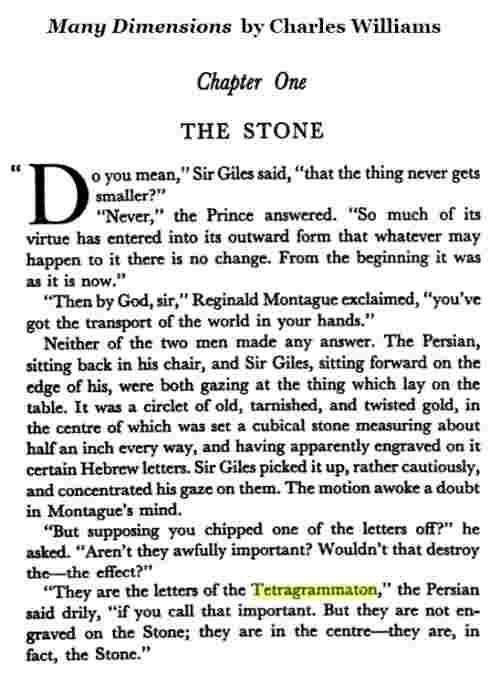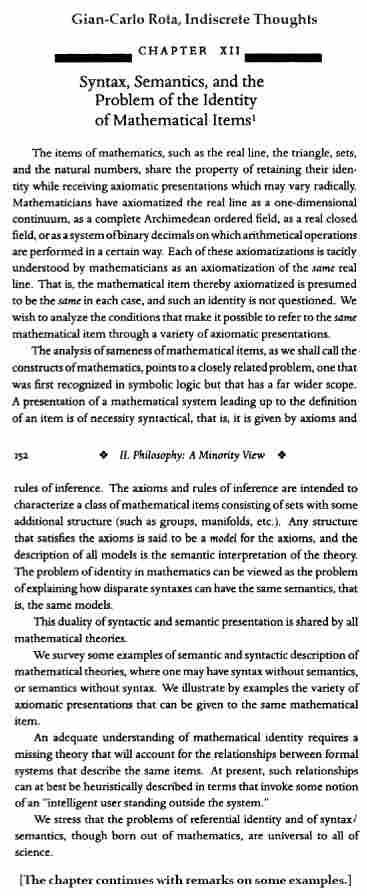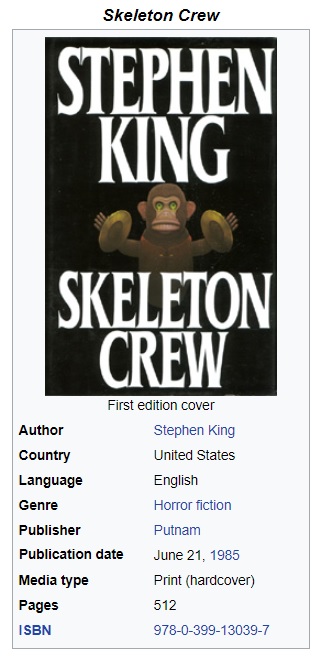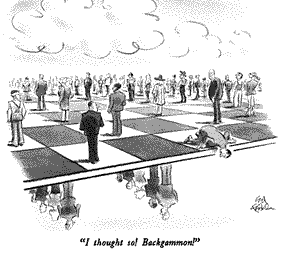Friday, March 29, 2024
Great Caesar’s Ghost!
Saturday, March 16, 2024
“Great Caesar’s Ghost!” — Cartoon Religious Exclamation
From Theodore Sturgeon's story "What Dead Men Tell" . . .

Update of 1:09 AM ET Saturday, March 16, 2024
(Source: a Substack email received at 12:37 AM ET) —

Wednesday, December 5, 2018
Caesarian (continued)
Thursday, March 15, 2012
The Head of Caesar
Remarks on Citizen Kane from The New York Times—
"… a kind of metaphysical detective story…. At the end we realize that the fragments are not governed by any secret unity: the detested Charles Foster Kane is a simulacrum, a chaos of appearances.” Borges concluded by quoting Chesterton, "there is nothing more frightening than a labyrinth that has no center." *
* The actual quote is from a Father Brown mystery, "The Head of Caesar," "'What we all dread most,' said the priest in a low voice, 'is a maze with no centre….'"
Thursday, December 2, 2010
Caesarian
The Dreidel Is Cast
The Nietzschean phrase "ruling and Caesarian spirits" occurred in yesterday morning's post "Novel Ending."
That post was followed yesterday morning by a post marking, instead, a beginning— that of Hanukkah 2010. That Jewish holiday, whose name means "dedication," commemorates the (re)dedication of the Temple in Jerusalem in 165 BC.
The holiday is celebrated with, among other things, the Jewish version of a die— the dreidel . Note the similarity of the dreidel to an illustration of The Stone* on the cover of the 2001 Eerdmans edition of Charles Williams's 1931 novel Many Dimensions—

For mathematics related to the dreidel , see Ivars Peterson's column on this date fourteen years ago.
For mathematics related (if only poetically) to The Stone , see "Solomon's Cube" in this journal.
Here is the opening of Many Dimensions—

For a fanciful linkage of the dreidel 's concept of chance to The Stone 's concept of invariant law, note that the New York Lottery yesterday evening (the beginning of Hanukkah) was 840. See also the number 840 in the final post (July 20, 2002) of the "Solomon's Cube" search.
Some further holiday meditations on a beginning—
Today, on the first full day of Hanukkah, we may or may not choose to mark another beginning— that of George Frederick James Temple, who was born in London on this date in 1901. Temple, a mathematician, was President of the London Mathematical Society in 1951-1953. From his MacTutor biography—
"In 1981 (at the age of 80) he published a book on the history of mathematics. This book 100 years of mathematics (1981) took him ten years to write and deals with, in his own words:-
those branches of mathematics in which I had been personally involved.
He declared that it was his last mathematics book, and entered the Benedictine Order as a monk. He was ordained in 1983 and entered Quarr Abbey on the Isle of Wight. However he could not stop doing mathematics and when he died he left a manuscript on the foundations of mathematics. He claims:-
The purpose of this investigation is to carry out the primary part of Hilbert's programme, i.e. to establish the consistency of set theory, abstract arithmetic and propositional logic and the method used is to construct a new and fundamental theory from which these theories can be deduced."
For a brief review of Temple's last work, see the note by Martin Hyland in "Fundamental Mathematical Theories," by George Temple, Philosophical Transactions of the Royal Society, A, Vol. 354, No. 1714 (Aug. 15, 1996), pp. 1941-1967.
The following remarks by Hyland are of more general interest—
"… one might crudely distinguish between philosophical and mathematical motivation. In the first case one tries to convince with a telling conceptual story; in the second one relies more on the elegance of some emergent mathematical structure. If there is a tradition in logic it favours the former, but I have a sneaking affection for the latter. Of course the distinction is not so clear cut. Elegant mathematics will of itself tell a tale, and one with the merit of simplicity. This may carry philosophical weight. But that cannot be guaranteed: in the end one cannot escape the need to form a judgement of significance."
— J. M. E. Hyland. "Proof Theory in the Abstract." (pdf)
Annals of Pure and Applied Logic 114, 2002, 43-78.
Here Hyland appears to be discussing semantic ("philosophical," or conceptual) and syntactic ("mathematical," or structural) approaches to proof theory. Some other remarks along these lines, from the late Gian-Carlo Rota—
See also "Galois Connections" at alpheccar.org and "The Galois Connection Between Syntax and Semantics" at logicmatters.net.
* Williams's novel says the letters of The Stone are those of the Tetragrammaton— i.e., Yod, He, Vau, He (cf. p. 26 of the 2001 Eerdmans edition). But the letters on the 2001 edition's cover Stone include the three-pronged letter Shin , also found on the dreidel . What esoteric religious meaning is implied by this, I do not know.
Saturday, October 21, 2017
Back to Halloween Season
Sunday, August 6, 2017
Dark Tower Theology
In memory of a TV gunslinger who reportedly died Thursday, August 3, 2017 . . .
From this journal on that day (posts now tagged Dark Tower Theology) —
"The concept under review is that of the Holy Trinity.
See also, in this journal, Cube Trinity.
For a simpler Trinity model, see the three-point line …"
Tuesday, April 4, 2017
Night at the Museum
"Do you know what he called this place? A museum."
Update of 11:06 PM ET —
A search for background on the "Holiday" screenplay leads,
via a useful historical website, to …
Other Hollywood material —
Thursday, June 9, 2016
Saturday, February 6, 2016
Sneak Preview
Wikipedia on a George Clooney film released yesterday —
"The studio's major production is Hail, Caesar! ,
an epic set in ancient Rome and starring Baird Whitlock
(Clooney). During a shoot, Whitlock drinks from a goblet
of wine drugged by an extra; he passes out behind the
soundstage and is abducted. A ransom note soon arrives,
written by a group calling itself 'The Future' and demanding
$100,000, which Mannix arranges to have paid. Whitlock
awakens in a beach house and finds his way into a meeting
of The Future, a Communist cell. The members explain their
doctrine to him, and he begins to sympathize with their cause."
See also this morning's post Space Program:
"Bad news on the doorstep…." — American Pie

Wednesday, January 20, 2016
Jeer vs. Sneer in the New Year
Jeer yesterday by Sarah Palin —
“No more pussy-footin’ around!"
Sneer in The Washington Post this morning —
By Chris Cillizza* January 20 at 7:11 AM
"Sarah Palin endorsed Donald Trump's presidential campaign
on Tuesday in Iowa. You may have heard that — unless you
were hiding under a pile of coats for the day. But, what you
likely missed is the speech — and I use that word advisedly —
that Palin gave …."
Year by Don Henley —
* Cillizza is the author of The Gospel According to the Fix .
See also Sunday's post New York Values, with its quote from
a review of the new Coen brothers film "Hail, Caesar!" about
the world of the Hollywood "fixer."
Sunday, January 17, 2016
New York Values
The phrase "experimental techniques" in the previous post
suggests the following words and images.
From The New York Times online this evening —
"Think 'Barton Fink' meets 'A Serious Man.'
With dancing."
Okay …

"When the truth is found to be lies
And all the joy within you dies…."
"We're entering Weimar, baby."
— Peggy Noonan
Thursday, October 2, 2014
Titles
From the title page of a book quoted here yesterday:

Another title, in memory of a former mayor of Tel Aviv who reportedly died yesterday:
“President Reuven Rivlin called Lahat ‘Tel Aviv’s Herod,’
referring to the semi-mythical Jewish king whose epic
construction projects, including the Temple Mount,
Masada and Caesarea, remain standing 2,000 years after
his death.” — The Times of Israel
Wednesday, February 12, 2014
Saturday, October 1, 2011
The Crowe Sphere
From Wallace Stevens's "A Primitive Like an Orb"—
But the virtuoso never leaves his shape,
Still on the horizon elongates his cuts,
And still angelic and still plenteous,
Imposes power by the power of his form.
See also the film Virtuosity and The Crowe Sphere
(a Log24 search that includes, by accident, a post
with the phrase "he crowed exultantly.").
Such a crowing: Cagney's classic "Top of the world!"
Those who seek significance in the name of Crowe's
character in Virtuosity , "SID 6.7," may consult yesterday's
Primordiality and a related post of 6.7 (June 7), 2010.
(For the "SID" part, see Caesar in this journal and Gladiator.)
Sunday, December 19, 2010
Rosetta and the Stone
"Brightest and Best of the Stars of the Morning"
— Title of a Christian propaganda* song
Rosetta Jacobs (alias Piper Laurie) as the wife of Joseph Goebbels ("The Bunker," 1981)
For the Stone of the title, see Caesarian, The Tiffany Puzzle, and Willkommen .
For Rosetta, see Three in One and a sequel, Stella.
* See an article on Oberammergau and a pastor's weblog with the song in that setting (but with place-name suppressed).
Tuesday, August 10, 2010
Architecture Continued
Yesterday's architectural entertainment coincided, more or less, with the New York Times article "The Hand of a Master Architect" (Online Sunday, Aug. 8, and in the print edition Monday, Aug. 9).
A search for some background on that architect (Philip Johnson, not Howard Roark) showed that the Art Libraries Society of North America published a notable graphic logo in 2005—

See this journal on April 7, 2005, for a related graphic design.
The ARLIS/NA 2005 page cited above says about Houston, Texas, that
"Just beyond the museum district lies Rice University, the city's most prestigious and oldest college….
Other campuses that contain significant architecture include St. Thomas University where Philip Johnson has made his mark for a period that extends more than forty years."

University of St. Thomas, Chapel of St. Basil
Applying Jungian synchronicity, we note that Johnson designed the Chapel of St. Basil at the University of St. Thomas, that the traditional date of the Feast of St. Basil is June 14, and that this journal on that date contained the following, from the aforementioned Rice University—
… a properly formulated Principle of Sufficient Reason plays
a fundamental role in scientific thought and, furthermore, is
to be regarded as of the greatest suggestiveness from the
philosophic point of view.2
… metaphysical reasoning always relies on the Principle of
Sufficient Reason, and… the true meaning of this Principle
is to be found in the “Theory of Ambiguity” and in the associated
mathematical “Theory of Groups.”
If I were a Leibnizian mystic, believing in his “preestablished
harmony,” and the “best possible world” so satirized by Voltaire
in “Candide,” I would say that the metaphysical importance of
the Principle of Sufficient Reason and the cognate Theory of Groups
arises from the fact that God thinks multi-dimensionally3
whereas men can only think in linear syllogistic series, and the
Theory of Groups is the appropriate instrument of thought to
remedy our deficiency in this respect.
The founder of the Theory of Groups was the mathematician
Evariste Galois….
2 As far as I am aware, only Scholastic Philosophy has fully recognized
and exploited this principle as one of basic importance for philosophic thought.
3 That is, uses multi-dimensional symbols beyond our grasp.
For more about Scholastic Philosophy, see the Center for Thomistic Studies at the University of St. Thomas.
For more about the graphic symbol shown (as above) by ARLIS and by Log24 in April 2005, see in this journal "rature sous rature ."
Wednesday, March 17, 2010
Prime Directive
Rigor
“317 is a prime, not because we think so,
or because our minds are shaped in one way
rather than another, but because it is so,
because mathematical reality is built that way.”
– G. H. Hardy,
A Mathematician’s Apology

The above photo is taken from
a post in this journal dated
March 10, 2010.
This was, as the Pope might say,
the dies natalis of a master gameplayer–
| New York Times, March 16, 2010–
Tim Holland, Backgammon Master, Tim Holland, who was widely considered the world’s greatest backgammon player during that ancient board game’s modern heyday, in the 1960s and ’70s, died on March 10 at his home in West Palm Beach, Fla. He was 79. <<more>> |
In Holland's honor, a post
from Columbus Day, 2004—
Tuesday October 12, 200411:11 PM Time and Chance
Today’s winning lottery numbers
|
A quote from Holland on backgammon–
"It’s the luck factor that seduces everyone
into believing that they are good,
that they can actually win,
but that’s just wishful thinking."
For those who are, like G.H. Hardy,
suspicious of wishful thinking,
here is a quote and a picture from
Holland's ordinary birthday, March 3—
"The die is cast." — Caesar
Wednesday, March 3, 2010
Plato’s Ghost
Jeremy Gray, Plato's Ghost: The Modernist Transformation of Mathematics, Princeton, 2008–
"Here, modernism is defined as an autonomous body of ideas, having little or no outward reference, placing considerable emphasis on formal aspects of the work and maintaining a complicated— indeed, anxious— rather than a naïve relationship with the day-to-day world, which is the de facto view of a coherent group of people, such as a professional or discipline-based group that has a high sense of the seriousness and value of what it is trying to achieve. This brisk definition…."
Brisk? Consider Caesar's "The die is cast," Gray in "Solomon's Cube," and yesterday's post—
This is the group of "8 rigid motions
generated by reflections in midplanes"
of Solomon's Cube.
Related material:
"… the action of G168 in its alternative guise as SL(3; Z/2Z) is also now apparent. This version of G168 was presented by Weber in [1896, p. 539],* where he attributed it to Kronecker."
— Jeremy Gray, "From the History of a Simple Group," in The Eightfold Way, MSRI Publications, 1998
Here MSRI, an acronym for Mathematical Sciences Research Institute, is pronounced "Misery." See Stephen King, K.C. Cole, and Heinrich Weber.
*H. Weber, Lehrbuch der Algebra, Vieweg, Braunschweig, 1896. Reprinted by Chelsea, New York, 1961.
Sunday, May 25, 2008
Sunday May 25, 2008
— Song lyric, Cyndi Lauper
Magister Ludi
Hermann Hesse's 1943 The Glass Bead Game (Picador paperback, Dec. 6, 2002, pp. 139-140)–
"For the present, the Master showed him a bulky memorandum, a proposal he had received from an organist– one of the innumerable proposals which the directorate of the Game regularly had to examine. Usually these were suggestions for the admission of new material to the Archives. One man, for example, had made a meticulous study of the history of the madrigal and discovered in the development of the style a curved that he had expressed both musically and mathematically, so that it could be included in the vocabulary of the Game. Another had examined the rhythmic structure of Julius Caesar's Latin and discovered the most striking congruences with the results of well-known studies of the intervals in Byzantine hymns. Or again some fanatic had once more unearthed some new cabala hidden in the musical notation of the fifteenth century. Then there were the tempestuous letters from abstruse experimenters who could arrive at the most astounding conclusions from, say, a comparison of the horoscopes of Goethe and Spinoza; such letters often included pretty and seemingly enlightening geometric drawings in several colors."
A Bulky Memorandum
From Siri Hustvedt, author of Mysteries of the Rectangle: Essays on Painting (Princeton Architectural Press, 2005)– What I Loved: A Novel (Picador paperback, March 1, 2004, page 168)–
A description of the work of Bill Wechsler, a fictional artist:
"Bill worked long hours on a series of autonomous pieces about numbers. Like O's Journey, the works took place inside glass cubes, but these were twice as large– about two feet square. He drew his inspiration from sources as varied as the Cabbala, physics, baseball box scores, and stock market reports. He painted, cut, sculpted, distorted, and broke the numerical signs in each work until they became unrecognizable. He included figures, objects, books, windows, and always the written word for the number. It was rambunctious art, thick with allusion– to voids, blanks, holes, to monotheism and the individual, the the dialectic and yin-yang, to the Trinity, the three fates, and three wishes, to the golden rectangle, to seven heavens, the seven lower orders of the sephiroth, the nine Muses, the nine circles of Hell, the nine worlds of Norse mythology, but also to popular references like A Better Marriage in Five Easy Lessons and Thinner Thighs in Seven Days. Twelve-step programs were referred to in both cube one and cube two. A miniature copy of a book called The Six Mistakes Parents Make Most Often lay at the bottom of cube six. Puns appeared, usually well disguised– one, won; two, too, and Tuesday; four, for, forth; ate, eight. Bill was partial to rhymes as well, both in images and words. In cube nine, the geometric figure for a line had been painted on one glass wall. In cube three, a tiny man wearing the black-and-white prison garb of cartoons and dragging a leg iron has
— End of page 168 —
opened the door to his cell. The hidden rhyme is "free." Looking closely through the walls of the cube, one can see the parallel rhyme in another language: the German word drei is scratched into one glass wall. Lying at the bottom of the same box is a tiny black-and-white photograph cut from a book that shows the entrance to Auschwitz: ARBEIT MACHT FREI. With every number, the arbitrary dance of associations worked togethere to create a tiny mental landscape that ranged in tone from wish-fulfillment dream to nightmare. Although dense, the effect of the cubes wasn't visually disorienting. Each object, painting, drawing, bit of text, or sculpted figure found its rightful place under the glass according to the necessary, if mad, logic of numerical, pictorial, and verbal connection– and the colors of each were startling. Every number had been given a thematic hue. Bill had been interested in Goethe's color wheel and in Alfred Jensen's use of it in his thick, hallucinatory paintings of numbers. He had assigned each number a color. Like Goethe, he included black and white, although he didn't bother with the poet's meanings. Zero and one were white. Two was blue. Three was red, four was yellow, and he mixed colors: pale blue for five, purples in six, oranges in seven, greens in eight, and blacks and grays in nine. Although other colors and omnipresent newsprint always intruded on the basic scheme, the myriad shades of a single color dominated each cube.
The number pieces were the work of a man at the top of his form. An organic extension of everything Bill had done before, these knots of symbols had an explosive effect. The longer I looked at them, the more the miniature constructions seemed on the brink of bursting from internal pressure. They were tightly orchestrated semantic bombs through which Bill laid bare the arbitrary roots of meaning itself– that peculiar social contract generated by little squiggles, dashes, lines, and loops on a page."
(named not for
Bill Wechsler, the
fictional artist above,
but for the non-fictional
David Wechsler) –
|
From 2002:
Above: Dr. Harrison Pope, Harvard professor of psychiatry, demonstrates the use of the Wechsler Adult Intelligence Scale "block design" subtest. |
A Magic Gallery
|
ZZ
Figures from the
Poem by Eugen Jost:
Mit Zeichen und Zahlen
Numbers and Names,
With numbers and names English translation A related poem:
Alphabets
From time to time
But if a savage
— Hermann Hesse (1943), |
Saturday, March 15, 2008
Saturday March 15, 2008
climax, every school year, with
the Mr. Julius Caesar contest….”
— Roger Ebert, review
of the 2002 film
“The Emperor’s Club“
And the winner is…
Client 9!
Wednesday, March 15, 2006
Wednesday March 15, 2006
continues…

Gallia est omnis divisa in partes tres,
quarum unam incolunt Belgae,
aliam Aquitani, tertiam qui ipsorum
lingua Celtae, nostra Galli appellantur.
Sunday, October 9, 2005
Sunday October 9, 2005
Magical Thinking
the first generator at Boulder
(later Hoover) Dam began
transmitting electricity to Los Angeles."
— Today in History, Associated Press
generates radiance."
— Hexagram 30
"I know what nothing means."
— Maria Wyeth in Play It As It Lays
"Nothing is random."
— Mark Helprin in Winter's Tale
"… She thought about nothing. Her mind was a blank tape, imprinted daily with snatches of things overheard, fragments of dealers' patter, the beginnings of jokes and odd lines of song lyrics. When she finally lay down nights in the purple room she would play back the day's tape, a girl singing into a microphone and a fat man dropping a glass, cards fanned on a table and a dealer's rake in closeup and a woman in slacks crying and the opaque blue eyes of the guard at some baccarat table. A child in the harsh light of a crosswalk on the Strip. A sign on Fremont Street. A light blinking. In her half sleep the point was ten, the jackpot was on eighteen, the only man that could ever reach her was the son of a preacher man, someone was down sixty, someone was up, Daddy wants a popper and she rode a painted pony let the spinning wheel spin.
By the end of a week she was thinking constantly about where her body stopped and the air began, about the exact point in space and time that was the difference between Maria and other. She had the sense that if she could get that in her mind and hold it for even one micro-second she would have what she had come to get. As if she had fever, her skin burned and crackled with a pinpoint sensitivity. She could feel smoke against her skin. She could feel voice waves. She was beginning to feel color, light intensities, and she imagined that she could be put blindfolded in front of the signs at the Thunderbird and the Flamingo and know which was which. 'Maria,' she felt someone whisper one night, but when she turned there was nobody.
She began to feel the pressure of Hoover Dam, there on the desert, began to feel the pressure and pull of the water. When the pressure got great enough she drove out there. All that day she felt the power surging through her own body. All day she was faint with vertigo, sunk in a world where great power grids converged, throbbing lines plunged finally into the shallow canyon below the dam's face, elevators like coffins dropped into the bowels of the earth itself. With a guide and a handful of children Maria walked through the chambers, stared at the turbines in the vast glittering gallery, at the deep still water with the hidden intakes sucking all the while, even as she watched, clung to the railings, leaned out, stood finally on a platform over the pipe that carried the river beneath the dam. The platform quivered. Her ears roared. She wanted to stay in the dam, lie on the great pipe itself, but reticence saved her from asking.
'Just how long have you been here now,' Freddy Chaikin asked when she ran into him in Caesar's. 'You planning on making a year of it? Or what?'"
Related material
The front page of today's
New York Times Book Review
and Log24, July 15, 2004:
|
A quotation that somehow
seems relevant:
O the mind, mind has mountains, |
Thursday, June 2, 2005
Thursday June 2, 2005
at the Altar of Facts
From Log24,
April 28, 2005:
(See also Log24,
April 5, 2005.)
Compare this diagram with that of
Samuel Beckett in Quad (1981):

Related quotation:
Barry Mazur on a seminal paper of algebraist Saunders Mac Lane:
The paper was rejected “because the editor thought that it was ‘more devoid of content’ than any other he had read. ‘Saunders wrote back and said, “That’s the point,”‘ Mazur said. ‘And in some ways that’s the genius of it. It’s the barest, most Beckett-like vocabulary that incorporates the theory and nothing else.'”

Prime Minister of France:
“M. de Villepin positively worships Napoleon, and models himself after his hero. In a 600-page biography, Villepin wrote admiringly about the difference between great men like Napoleon and the ‘common run’ of men. It is worth reading every word carefully.
‘Here we touch on that particular essence of great men, on what distinguishes Napoleon or Alexander, Caesar or de Gaulle, from the common run. It is excess, exaltation, and a taste for risk that forms their genius. It is why they are often better understood in their élan by writers and poets, who are possessed of the same thirst for the absolute, than by those who pray at the altar of facts.’
(New Republic)
And in praise of French nationalism, de Villepin wrote,
‘The Gaullist adventure renewed the élan of [Napoleon’s] Consulate through the restoration of a strong executive and the authority of the State, the same scorn for political parties and for compromise, a common taste for action, and an obsession with the general interest and the grandeur of France.’
Those words come straight from 1800. Napoleon’s ‘genius,’ his ‘thirst for the absolute,’ ‘excess, exaltation, and a taste for risk,’ ‘a strong executive and the authority of the State,’ ‘his ‘scorn for political parties and for compromise,’ and ‘an obsession with the grandeur of France’ — it is all classic national hero worship. But today that kind of thinking is used to promote a new vision of destiny, the European Union.”
Monday, March 15, 2004
Monday March 15, 2004
The Fog and the Fury
Headline and opening sentence of a column in the Washington Times:
“Job creation fog . . . and fury
Something must be done [to] restore jobs in U.S. manufacturing….”
So far, so good. But the columnist goes on to explain the recent loss of manufacturing jobs:
“Let’s be honest. Some of these manufacturing jobs will not be coming back because of structural changes in our economy. Manufacturers have been reducing payrolls, in middle management and on the production line, because they have found ways to produce more goods at far less cost, boosting profits for further expansion and fatter investor and worker pension dividends.”
Uh-huh.
Here is a different explanation (the “fury,” as opposed to “the fog”), from a March 10 column:
“Last week’s jobs report, with hundreds of thousands giving up the search for work, and manufacturing jobs disappearing for the 43rd straight month, jolted the White House. What is going on?
They’re calling it a jobless recovery. Wrong. Millions of jobs are being created. They’re just not being created here in the United States.
The reasons can be traced to these four acronyms: NAFTA, GATT, WTO, PNTR. These are the trade treaties and global institutions that have permitted the historic substitution of foreign labor for American labor, to the enrichment of the transnational companies that look upon the Congress as a wholly owned subsidiary….
For the Bush Republicans, the chickens are coming home to roost….
At a weekend conference on immigration and jobs hosted by The American Cause, which this writer chairs, one speaker blurted out that while he voted for Bush in 2000, he would never do so again. The room erupted in applause, though virtually all there were conservatives, and all had once been Goldwater-Nixon-Reagan Republicans.”
— Pat Buchanan, author of
A Republic, Not an Empire

Happy Ides, Caesar.
Saturday, November 15, 2003
Saturday November 15, 2003
From the
Empty Center:
|
From Friday's 2:56 AM entry —
Philip K. Dick,
"Sun at the top.
"Do you know "Yes," Hawthorne said.
"It's Chung Fu," Juliana said.
Margo Jefferson in
"When a classical text is modernized, |
Today's previous entry, "Aes Triplex," is actually from 1:48 PM EST yesterday. (It was posted to my alternate site, log24.com, since log24.net was down for Xanga maintenance.) "Aes Triplex" deals with image and reality.
Its final link, to the heart of Rome, leads to Julius Caesar.
A related review in today's New York Times:
"We live in a media maelstrom, and the Moonwork theater company's 'Julius Caesar' comes hurtling toward us right from its center. This production, at the Connelly Theater in the East Village through Nov. 23, is set in the here and now.
'Julius Caesar' is about politics, rhetoric and power; about manipulation of a nation's image and its people; about conspiracy, murder and the war that leads to a new regime. What play is better suited for our times?"
Wednesday, March 5, 2003
Wednesday March 5, 2003
Ash Wednesday
Brace Yourself, Maureen
From Maureen Dowd’s New York Times column today:
“During the innocent summer before 9/11, the defense secretary’s office sponsored a study of ancient empires — Macedonia, Rome, the Mongols — to figure out how they maintained dominance.
What tips could Rummy glean from Alexander the Great, Julius Caesar and Genghis Khan?”
Background briefing, added at 6:29 AM:
See also the use of the hyperbolic paraboloid in Mexican church architecture by Félix Candela and an essay on saddle surfaces by Joseph F. MacDonnell, Society of Jesus, who spent eight years in Iraq teaching physics and mathematics at two Jesuit schools in Baghdad: Baghdad College and Al Hikma University. He writes that “since the 1968 Baathi takeover of the two Jesuit schools and expulsion of all Jesuits from Iraq in 1969” he has been teaching mathematics at Fairfield University.
MacDonnell notes that there are only three doubly ruled surfaces (in real 3-space): the hyperboloid (used for nuclear cooling towers), the hyperbolic paraboloid (used, as noted, for Mexican churches), and the plane (used widely). The geometry here is perhaps less relevant than the existence of the Society of Jesus as a sort of intelligence agency within the Church — an agency the current Pope has never understood how to use. Opus Dei is a greatly inferior substitute.





























